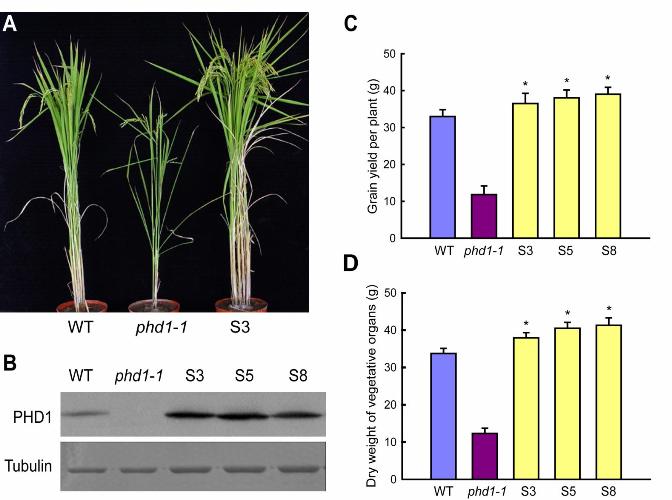Photosynthesis is a chemical process that converts carbon dioxide into organic compounds, especially sugars, using the energy from sunlight. Nearly all life on Earth depends on it, either as a direct source of energy, or indirectly, as the ultimate source of the energy in their food, as well as maintaining the normal level of oxygen in the atmosphere.
Photosynthesis is the final determinator for crop yield. Photosynthesis takes place in organelles called chloroplasts. To gain insight into genes controlling photosynthetic capacity, scientists in Dr. Chengcai Chu’s group from the Institute of Genetics and Developmental Biology, the Chinese Academy of Sciences carried out an extensive screening of their large rice T-DNA mutant population, and isolated a rice stunted growth mutant with decreased carbon assimilate and yield production named photoassimilate defective1 (phd1). Molecular and biochemical analyses revealed that PHD1 encodes a novel chloroplast-localized UDP-glucose epimerase (UGE), which catalyzes the reversible conversion of UDP-galactose to UDP-glucose. UDP-galactose is the donor for galactose-containing glycerolipids (mono- and digalactosyldiacylglycerol (MGDG and DGDG)), which are predominant lipid components of photosynthetic membranes. The relative amount of MGDG was decreased in the phd1 mutant, suggesting that PHD1 participates mainly in UDP-galactose supply for MGDG biosynthesis in chloroplasts. The phd1 mutant showed decreased chlorophyll content, photosynthetic activity, and altered chloroplast ultrastructure. Most strikingly, PHD1 overexpression increased photosynthetic efficiency, biomass, and grain production, suggesting that PHD1 has significant economic implications in both traditional crop improvement and bioenergy crop production.
This work with Dr. Chunlai Li as the first author has been online published on PLoS Genetics (DOI:10.1371/journal.pgen.1002196). This research was supported by grants from Chinese Academy of Sciences, Ministry of Science and Technology, Ministry of Agriculture of China, and National Natural Science Foundation of China.
AUTHOR CONTACT:
Chengcai Chu, Ph.D.
Institute of Genetics and Developmetnal Biology, Chinese Academy of Sciences, Beijing, China.
E-mail: ccchu@genetics.ac.cn

(Image by Li Chunlai etc.)
Figure.Agricultural traits of transgenic rice overexpressing PHD1. (A) Phenotypic differences of wild type, phd1-1, and transgenic line S3 at the grain-filling stage grown in paddy fields.(B)Immunoblot analysis of PHD1 protein expression in wild type, phd1-1, and PHD1 overexpressing transgenic lines (S3, S5, and S8). Tubulin is shown as loading control. Increased accumulation of PHD1 protein was observed in transgenic lines. (C, D)Grain yield per plant (C) and dry weight of vegetative organs after harvesting (D) were increased in transgenic plants. Values are means ± SD from at least 30 plants/line. Asterisks indicate a statistically significant difference from the wild type (*P < 0.05, Student’s t-test).



